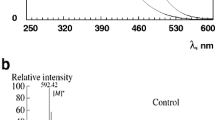Abstract
It has been established that the development of cataract is accompanied by the formation of various fluorophores in the lipid fraction of the lens. These lipid-fluorescing products have been separated chromatographically according to polarity and molecular weight. It is shown that the initial stages of the development of cataract are characterized by the appearance of lipid fluorophores in the near ultraviolet and violet regions of the spectrum (excitation maximum 302–330 nm, emission maximum 411 nm) with low polarity and a small molecular weight; the maturing of the cataract is characterized by an increase in the intensity of the long-wave fluorescence of the lipids in the blue-green region (430–480 nm) and by the formation of polymeric high-molecular-weight fluorescing lipid products with high polarity. It has been demonstrated that the appearance of lipid fluorophores in the crystalline lens is associated with the free radical oxidative modification of the phospholipids and fatty acids in cataract.
Similar content being viewed by others
References
Augusteyn R (1975) Distribution of fluorescence in human cataractous lens protein. Ophthalmic Res 7:214–224
Babizhayev M, Deyev A (1986) Free radical oxidation of lipids and thiol groups during cataractogenesis (in Russian). Biofizika 31:109–114
Babizhayev M, Shvedova A, Archipenko Yu, Kagan V (1985) Accumulation of lipid peroxidation products in the lens in cataract. Bull Exp Biol Med 100:1199–1201
Bando M, Nakajima A, Satoh K (1975) Coloration of human lens proteins. Exp Eye Res 20:489–492
Bando M, Mikuni I, Obazawa H (1982) Acceleration of calcium-induced aggregation of rat lens soluble protein by photosensitization with 8-methoxypsoralen and 3-OH-L-kynurenine O-betaglucoside. Exp Eye Res 34:953–956
Bensch K, Fleming J, Lohmann W (1985) The role of ascorbic acid in senile cataract. Proc Natl Acad Sci USA 82:7193–7196
Bhuyan K, Bhuyan D, Podos S (1981) Evidence of increased lipid peroxidation in cataracts. IRCS Med Sci 9:126–127
Bhuyan K, Master R, Coles R, Bhuyan D (1986) Molecular mechanisms of cataractogenesis. IV. Evidence of phospholipid-malondialdehyde adduct in human senile cataract. Mech Ageing Dev 34:289–296
Bidlack W, Tappel A (1973) Fluorescent products of phospholipids. Lipids 8: 203–209
Bolland J, Koch H (1945) The course of auto-oxidation reactions in polyisoprenes and allied compounds. Part IX. The primary thermal oxidation products of ethyl linoleate. J Chem Soc 7:445–447
Buckingham R, Pirie A (1972) The effect of light on lens protein in vivo. Exp Eye Res 14:297–299
Chio K, Tappel A (1969) Synthesis and characterization of the fluorescent products derived from malonaldehyde and amino acids. Biochemistry 8:2821–2827
Csallany A, Ayaz K (1976) Quantitative determination of organic solvent-soluble lipofuscin pigments in tissues. Lipids 11:412–417
Dillard C, Tappel A (1973) Fluorescent products from reaction of peroxidizing polyunsaturated fatty acids with phosphatidyl ethanolamine and phenylalanine. Lipids 8:183–189
Dillon J, Spector A (1980) A comparison of aerobic and anaerobic photolysis of lens protein. Exp Eye Res 31:591–597
Folch J, Lees M, Sloane Stanley G (1957) A simple method for the isolation and purification of total lipids from animal tissues. J Biol Chem 226:497–509
Garcia-Castineiras S, Dillon J, Spector A (1978) Non-tryptophan fluorescence with human lens protein. Apparent complexity and isolation of bityrosine and anthranilic acid. Exp Eye Res 26:461–477
Hockwin O, Lerman S (1982) Clinical evaluation of direct and photosensitized ultraviolet radiation damage to the lens. Ann Ophthalmol 14:220–223
Jacobs R, Krohn D (1981) Fluorescence intensity profile of human lens sections. Invest Ophthalmol Vis Sci 20:117–120
Kikugawa K (1986) Fluorescent products derived from the reaction of primary amines and components in peroxidized lipids. Adv Free Rad Biol Med 2:389–418
Lerman S (1976) Lens fluorescence in aging and cataract formation. Doc Ophthalmol 8: 241–260
Lerman S, Borkman R (1978) Ultraviolet radiation in the aging and cataractous lens. Acta Ophthalmol 56:139–149
Lohmann W, Wunderling M, Schehl W, Strobel J, Bensch K (1986) Nuclear cataract and ascorbic acid. Naturwissenschaften 73:266–267
Merzlyak M, Kovrizhnih V (1984) Lipid-phenolic radical adducts as a plausible mechanism of “plant ageing” pigment formation. Gen Physiol Biophys 3:497–505
Monnier V, Cerami A (1981) A non-enzymatic browning in vivo possible process for aging of long-lived proteins. Science 211:891–893
Murphy D, Mavis R (1981) A comparison of in vitro binding of α-tocopherol to microsomes of lung, liver, heart and brain of the rat. Biochim Biophys Acta 663:390–400
Orlov S, Danilov V, Malkov Yu, Rebrov V (1975) Free radical oxidation of the lipids of biological membranes. Fluorescence of fatty acids and phospholipids. Biophysics (translated from Biofizika) 20:231–235
Shvedova A, Platonov E, Polyansky N, Babizhayev M, Kagan V (1987) On the chemical nature of the fluorescent derivatives accumulating in lipids from the lenses with cataract. Bull Exp Biol Med 103:301–304 (in Russian)
Spector A (1984) The search for a solution to senile cataracts. Invest Ophthalmol Vis Sci 25:130–146
Spector A, Garner W (1981) Hydrogen peroxide and human cataract. Exp Eye Res 33:673–681
Spector A, Roy D, Stauffer J (1973) Isolation and characterization of an age-dependent polypeptide from human lens with non-tryptophan fluorescence. Exp Eye Res 21:9–24
Tappel A (1973) Lipid peroxidation damage to cell components. Fed Proc 32:1870–1874
Tappel A (1975) Lipid peroxidation and fluorescent molecular damage to membranes. In: Trump BF, Arstilla AU (eds) Patho-biology of cell membranes. Academic Press, New York, pp 145–170
Truscott R, Augusteyn R (1977) Oxidative changes in human lens proteins during senile nuclear cataract formation. Biochim Biophys Acta 494:43–52
Van Heyningen (1973) Photo-oxidation of lens proteins by sunlight in the presence of fluorescent derivatives of kinurenine isolated from the human lens. Exp Eye Res 17:137–147
Vaskovsky V, Kostetsky E (1968) Modified spray for the detection of phospholipids on thin-layer chromatograms. J Lipid Res 9:396
Zigler J, Goosey J (1981) Photosensitized oxidation in the ocular lens: evidence for photosensitizers endogenous to the human lens. Photochem Photobiol 33:869–875
Zigman S, Schultz J, Yulo T, Griess G (1973) The binding of photo-oxidized tryptophan to a lens gamma-crystallin. Exp Eye Res 17:209–219
Author information
Authors and Affiliations
Rights and permissions
About this article
Cite this article
Babizhayev, M.A. Lipid fluorophores of the human crystalline lens with cataract. Graefe's Arch Clin Exp Ophthalmol 227, 384–391 (1989). https://doi.org/10.1007/BF02169418
Received:
Accepted:
Issue Date:
DOI: https://doi.org/10.1007/BF02169418




